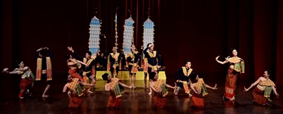ผลงานการแสดงสร้างสรรค์ชุด ยกธงสงกรานต์
คำสำคัญ:
การแสดงสร้างสรรค์, ชาติพันธุ์, ลาวครั่ง, ยกธงสงกรานต์บทคัดย่อ
การแสดงสร้างสรรค์ชุด ยกธงสงกรานต์ มีวัตถุประสงค์เพื่อศึกษาประเพณียกธงของกลุ่มชาติพันธุ์ลาวครั่ง ตำบลบ่อกรุ อำเภอเดิมบางนางบวช จังหวัดสุพรรณบุรี และสร้างสรรค์การแสดงชุด “ยกธงสงกรานต์” ในรูปแบบนาฏศิลป์พื้นบ้าน โดยนำข้อมูลมาจากประวัติศาสตร์ ประเพณี และวิถีชุมชนของลาวครั่งบ้านบ่อกรุ โดยผ่านกระบวนการสร้างสรรค์งานศิลปะและกระบวนการวิจัยที่ต้องการสร้างสิ่งใหม่ให้ได้ประโยชน์ทางด้านนาฏศิลป์ ผลการวิจัยพบว่า 1) ความเป็นมาของประเพณียกธงสงกรานต์นั้นเกิดขึ้นมาจากการอพยพของกลุ่มชาติพันธุ์ลาวครั่งเข้ามาในพื้นที่ตำบลบ่อกรุ อำเภอเดิมบางนางบวช จังหวัดสุพรรณบุรี ได้มีการยกธงขึ้นเพื่อแสดงถึงความสำเร็จที่สามารถหาพื้นที่อุดมสมบูรณ์ได้ ต่อมานำการยกธงมาเป็นส่วนหนึ่งของประเพณีสงกรานต์ เพื่ออนุรักษ์และปลูกฝังให้เห็นความสำคัญของบรรพบุรุษ 2) กระบวนการสร้างสรรค์ใช้หลักการทำงานนาฏยประดิษฐ์เป็นกรอบในการทำงาน รูปแบบการแสดงและกระบวนท่าฟ้อน คือ ช่วงที่ 1 ที่มาของลาวครั่ง แสดงให้เห็นถิ่นฐานดั้งเดิมที่บรรพบุรุษอพยพมาจากหลวงพระบาง ผ่านทางทำนองเพลงและกระบวนท่าฟ้อนของหญิงสาวที่ร่าเริง ท่าฟ้อนของฝ่ายชายแสดงถึงความแข็งแกร่ง ความเป็นผู้นำ ช่วงที่ 2 วิถีลาวครั่ง แสดงให้เห็นถึงวิถีชีวิตของหนุ่มสาว ใช้ท่าฟ้อนเกี้ยว พาราสี และช่วงที่ 3 ประเพณีลาวครั่ง เป็นการแสดงออกถึงความสามัคคีและร่วมมือร่วมใจของคนในชุมชน ผู้แสดงจะนำธงออกมาแห่แหนและปักลงบนพื้นดิน ดนตรีและเพลงได้สร้างสรรค์ขึ้นใหม่ ผลงานชุดยกธงสงกรานต์นี้แสดงให้เห็นถึงบทบาทของกลุ่มชาติพันธุ์ในจังหวัดสุพรรณบุรีที่พยายามใช้ยุทธศาสตร์ด้านการท่องเที่ยวมาเพิ่มรายได้แก่ชุมชน ถือได้ว่าผลงานชุดนี้สามารถช่วยให้สังคมรู้จักและเข้าใจกลุ่มชาติพันธุ์ลาวครั่งในจังหวัดสุพรรณบุรีได้อย่างละเอียดชัดเจนยิ่งขึ้น
เอกสารอ้างอิง
ชมพูนาฏ ชมภูพันธ์, สรินทร คุ้มเขต และจุฑาภรณ์ จันทบาล. (2558). “การวิจัยและพัฒนาศิลปะการแสดงท้องถิ่นของจังหวัดเลย โดยกระบวนการวิจัยเชิงปฏิบัติการแบบมีส่วนร่วม”. วารสารวิจัยและพัฒนา มหาวิทยาลัยราชภัฏเลย, 10, 32: 83-90.
เบญจมาศ กาฬภักดี. (2558). วัดบ่อกรุ อำเภอเดิมบางนางบวช จังหวัดสุพรรณบุรี. [ออนไลน์]. ค้นเมื่อ 15 มกราคม 2560. เข้าถึงจาก http://banjamatgame.wordpress.com
พระครูโกมุทสุวรรณาภรณ์. เจ้าอาวาสวัดบ่อกรุ. สัมภาษณ์, 20 ตุลาคม 2559.
รุ้งนภา ยรรยงเกษมสุข. (2555). “การโหยหาอดีต ความเป็นอดีตในสังคมสมัยใหม่ Nostalgia: Ancient in Modern Society”. วารสารการเมือง การบริหารและกฎหมาย คณะรัฐศาสตร์และนิติศาสตร์ มหาวิทยาลัยบูรพา, 4, 2: 59-89.
วิศัลย์ โฆษิตานนท์. (2557). ไทหล่มและลาวพุงขาว. [ออนไลน์]. ค้นเมื่อ 20 ธันวาคม 2559. เข้าถึงจาก http://wison_k@hotmail.com
สถาบันบัณฑิตพัฒนศิลป์. (2560). การนำเสนอผลงานสร้างสรรค์ด้านนาฏศิลป์และดนตรี ชุด ยกธงสงกรานต์ โดย วิทยาลัยนาฏศิลปสุพรรณบุรี สถาบันบัณฑิตพัฒนศิลป์. [ออนไลน์]. ค้นเมื่อ 20 เมษายน 2561. เข้าถึงจาก http://Facebook Bpi Futsal League was live
_______. (2561). งานมหกรรมวัฒนธรรมสี่ภาค ใต้ร่มพระบารมีจักรีวงศ์ วิทยาลัยนาฏศิลปสุพรรณบุรี สถาบันบัณฑิตพัฒนศิลป์. [ออนไลน์]. ค้นเมื่อ 22 เมษายน 2561. เข้าถึงจาก http://Facebook Bpi Futsal League was live
สิริวัฒน์ คำวันสา. (2529). โครงการลุ่มน้ำท่าจีน: ภาษาและวรรณกรรม จ.สุพรรณบุรี นครปฐม. นครปฐม: มหาวิทยาลัยศิลปากร.
สุพิศ ศรีพันธุ์. (2555). ภูมิปัญญาการทอผ้าของคนไทยเชื้อสายลาวครั่งในเขตอำเภอ เดิมบางนางบวช จังหวัดสุพรรณบุรี. วิทยานิพนธ์ปริญญามหาบัณฑิต สาขาวิชาการปกครองท้องถิ่น มหาวิทยาลัยขอนแก่น.
_________ . หัวหน้าสำนักปลัดเทศบาลตำบลบ่อกรุ. สัมภาษณ์, 21 ตุลาคม 2559.

ดาวน์โหลด
เผยแพร่แล้ว
ฉบับ
ประเภทบทความ
สัญญาอนุญาต
บทความที่ได้รับการตีพิมพ์เป็นลิขสิทธิ์ของ สบศ.





